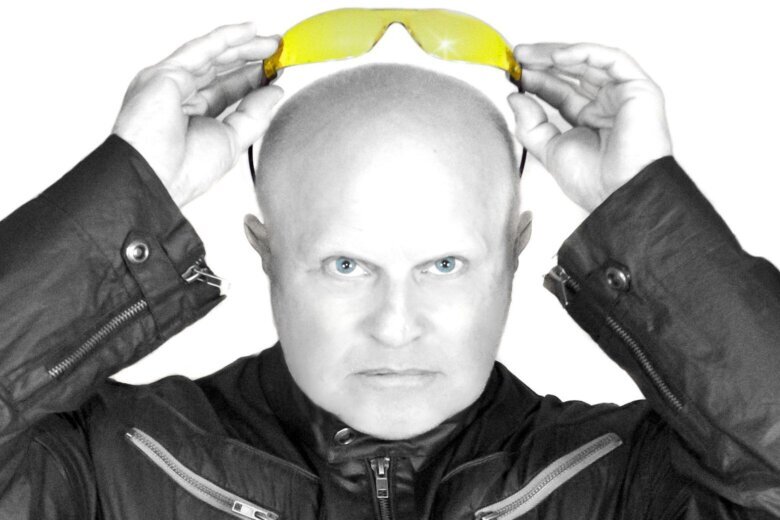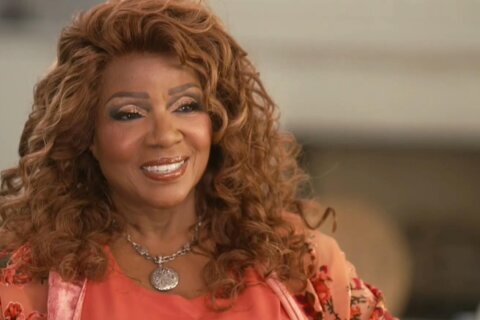Hear our full chat on my podcast “Beyond the Fame with Jason Fraley.”

It’s time for a Throwback Thursday with an ’80s new-wave band bringing live nostalgia to our area this weekend.
A Flock of Seagulls performs live at The Fillmore in Silver Spring, Maryland on Saturday night at 8 p.m.
“It’s still as much fun now as it ever was, so we don’t intend to stop anytime soon,” Frontman Mike Score told WTOP. “You get about a 50-50 mix. Of course, people come for the hits, then we play them what we call ‘future hits,’ some new songs, some songs that have been rearranged or changed differently.”
Born in Beverley, England in 1957, Score started out as a hairdresser in Liverpool before forming A Flock of Seagulls in 1979 with his brother Ali Score on drums, Frank Maudsley on bass and Paul Reynolds on guitar.
“I started out hairdressing and it was the punk period, so I ended up doing a lot of guys and girls who were in punk bands or went to punk shows, so in my hairdressing shop, they’d come in on a Friday after working in their office and be like, ‘Punk me up, I’m going out tonight,'” Score said.
How did he come up with his own unique hairdo with the middle combed down and the sides sticking up?
“When I was a kid I wanted to be a spaceman,” Score said. “On TV, spacemen had aerials coming out of their head, so that’s what I was emulating. Although I was outrageous, I was also very shy, so the front bit helped to cover up my eyes so I wasn’t getting stared at. … It kind of came about in an accidental way because I had a ‘Ziggy Stardust’ [hairstyle], but Frank, our original bass player, put his hand on top of that and it all collapsed down the front.”
Sporting uniquely futuristic hair and fashion style, the new-wave band released its self-titled debut album “A Flock of Seagulls” (1982), featuring the Grammy-winning instrumental song “D.N.A.”
“When we did it, we went, ‘Two chords, D and A, so let’s call it ‘D.N.A.,'” Score said. “I think D.N.A. was a big subject in the medical field then, so for us, it was like, man, we’re right on top of it here. … When it won a Grammy, I basically said, ‘Does that mean I’m a lousy singer?’ Because we didn’t get a Grammy for what I sang, you know?”
Of course, the album’s biggest hit was “I Ran (So Far Away),” which was in heavy rotation in the early days of MTV.
“We were looking for a record deal and went to a local record label in Liverpool and they had a picture on the wall of two people running away from a flying saucer,” Score said. “When we went back to rehearse, that was on my mind, so I just started to develop a story about that picture. … The guitar part just came from ‘we have a gap here, we need to do something interesting, so let’s do the spacey thing and have it go ‘jank jank jank’ down the line.'”
To his surprise, it became the band’s career song, but he doesn’t get tired of playing it.
“It doesn’t have to be fresh for us, the audience gets into it so much that we love playing it for them,” Score said. “Sometimes I actually stop singing it and just let them sing it. … It brings back a lot of memories over the years when it was written, then when it became a hit, then of course you do get tired of it and you go, ‘What’s wrong with my other songs? Why aren’t they this big?’ But then as you get older you go, ‘We’re lucky to have any hits.'”
It wasn’t the only hit. The band’s second album “Listen” (1983) featured “Wishing (If I Had a Photograph of You).”
“The band was having a break after the first album and I just went away and wrote ‘Wishing,'” Score said. “I played it to the record company and they said, ‘That’s your next single,’ so we went to the Bahamas and recorded it. It was so different from ‘I Ran.’ It was more of a ballad than ‘I Ran,’ so I was really happy that we weren’t just regurgitating ‘I Ran’ over and over again and ‘Wishing’ became a really big hit, too.”
Their third album “The Story of a Young Heart” (1984) included the song “The More You Live, the More You Love.”
“We were just in the Philippines and their favorite was ‘The More You Live, the More You Love,'” Score said. “I kind of think it was because in those countries they have a lot of respect for their parents. The story of that song is it’s something my mother said to me when I had a breakup. She said, ‘Don’t worry, son, the more you live, the more you love.’ I think that hit a chord with them down there in South America and the Philippines.”
At this point, Reynolds departed the band, causing Score to shake up the lineup for the fourth album “Dream Come True” (1986), featuring the song “Who’s That Girl?” The band briefly dissolved in 1988 before Score started it back up again for the fifth album “The Light at the End of the World” (1995), which didn’t sound very Seagull-ish.
“Paul decided he couldn’t take it anymore and left the band,” Score said. “All the songs on ‘Dream Come True’ were written for a solo thing I was going to do, but the record company said, ‘No, you’ve got to finish your Seagulls contract.’ … [‘Light at the End of the World’], some of it I liked, some of it I didn’t, some worked out the way I wanted, but I was still experimenting how I wanted to write songs. I didn’t want to keep repeating what I’d done.”
The band’s original members briefly reunited for two orchestral albums, “Ascension” (2018) with the Prague Philharmonic Orchestra, and “String Theory” (2021) with the Slovenian Symphonic Film Orchestra.
“The idea was that it was the same bunch of guys that wrote the songs now doing the orchestral versions,” Score said. “For us, it was like stepping back 30 years but moving forward because now there was an orchestra, which we’d never considered. It did kind of work out, but I wouldn’t let the original band play on any of my new stuff. I can say that because my new stuff is not A Flock of Seagulls as was, it’s as is the future.”
His new album arrives next spring, but you’ll hear singles from it this weekend at The Fillmore.
“I didn’t want any of the old guys to play on it because we’ve always had arguments about writing credits and stuff like that, so I’m like these are mine,” Score said. “As soon as you have a hit, it’s suddenly like, ‘Did I write that or did you?’ I’m a songwriter, that’s my thing, and I hate it when I write a song and somebody else comes along and goes, ‘Well, I played the bass on that, so I wrote it too.’ I’m like, ‘No you didn’t, you just played along with my song.'”
Regardless of the typical infighting over song credits, there’s no denying the band’s place in pop culture. A new generation is familiar with the band due to an homage in Quentin Tarantino’s “Pulp Fiction” (1994) where Samuel L. Jackson tells a dude with a funky hairdo, “You, Flock of Seagulls!” It’s also referenced in Damien Chazelle’s “La La Land” (2016) when Emma Stone requests Ryan Gosling’s pool-party band to play “I Ran.”
“I think the people that make those movies grew up liking A Flock of Seagulls,” Score said. “I think it’s brilliant because it shows that [40] years later, people are still talking about us, mainly I guess because of the haircut. It shows that in the end the band had something that is timeless. We didn’t know it at the time and it’s only these days that we look back and go, ‘Wow, man, what did we do? We just played a few songs and people still love them.'”
Listen to our full conversation on the podcast below:









